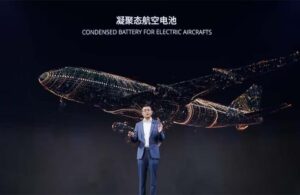Chinese EV firm, CATL has showcased a unique battery at Shanghai auto expo, claiming that it can power electric aircraft or propel electric vehicles (EVs) beyond 1,000 kilometres on a single charge.
 The company has shared few details about the technology but said it would start mass production later this year.
The company has shared few details about the technology but said it would start mass production later this year.
It was the latest in a series of big announcements for the industry, which is booming with the global shift to electrification.
“If you think about our electrified lives, if you took away batteries, none of this is possible,” said Adam Best, a principal research scientist at CSIRO.
“But people don’t think about batteries.”
CATL says its new battery almost doubles that figure, with a specific energy of 500Wh/kg.
CATL says the new design will go into mass production later this year and be used in civil aviation and road transport.
If the battery is as good as it claims, it will mean EVs can drive from Sydney to Melbourne on a single charge.
Batteries store energy in the form of chemical potential. As the amount of energy they store goes up, so does the challenge of keeping them stable, Best said.
“You’re trying to have something that’s electrochemically stable, thermally stable, and chemically stable. It has to be able to conduct ions at a range of different temperatures.”
“These materials that have to do so many different things in concert with each other. It’s really like a symphony, with all the parts playing its role.”
For its latest battery, CATL appears to have developed a type of highly conductive electrolyte gel, which saves on weight.
In a statement, it says the battery uses “condensed matter” as an electrolyte to improve the conductive performance of the cells, as well as “innovative” anode materials.
“CATL’s condensed battery leverages highly conductive biomimetic condensed state electrolytes to construct a micron-level self-adaptive net structure that can adjust the interactive forces among the chains, thus improving the conductive performance of the cells.”
The current crop of small aircraft outfitted with electric power systems operate at 250-270Wh/kg of specific energy.
One of the most promising emerging technologies is solid-state batteries, which use a solid electrolyte material instead of the liquid or gel used in conventional lithium-ion batteries.
A solid electrolyte drastically increases the battery’s energy density, as well as safety, as it avoids the need for flammable solvents used in liquid electrolytes.
“Solid-state batteries will play a role in getting rid of those liquid phases that can … cause gas and catch fire,” CSIROs Best said.
“These batteries were a long way from being made commercially available,” Best said.
“The opportunity of lithium-air batteries is immense, but the chemistry of oxygen reacting with lithium is really difficult to control.”
“This device would be an immense breakthrough if that was to work.”
The Commonwealth Scientific and Industrial Research Organisation (CSIRO) is an Australian Government agency responsible for scientific research.

